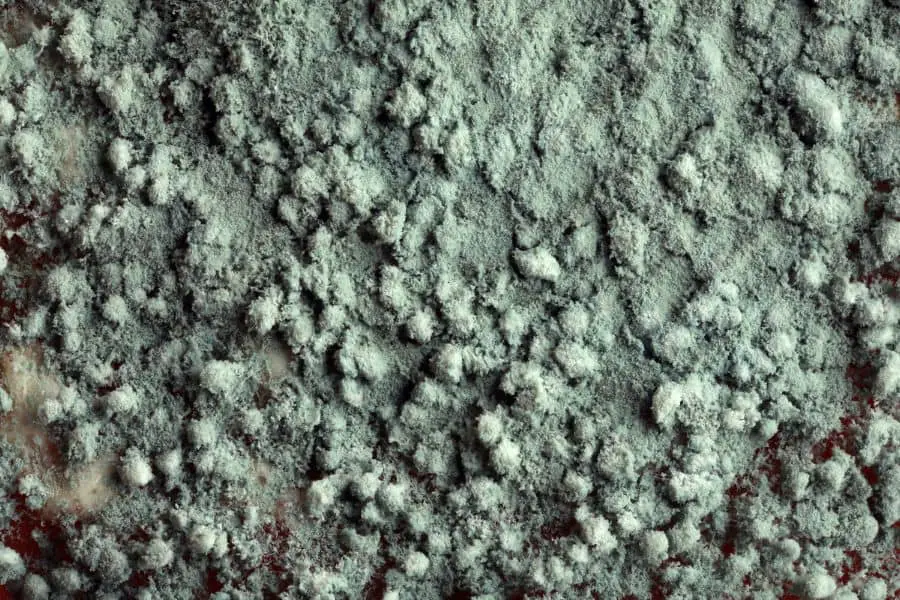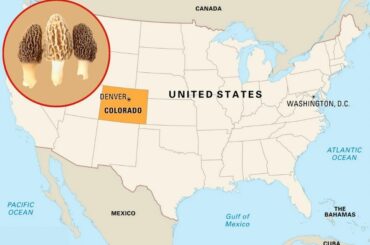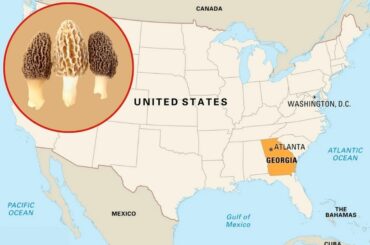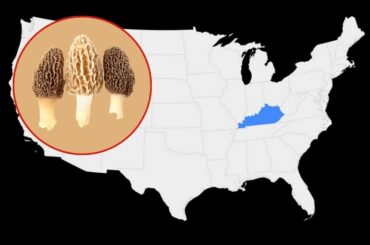Hi there, fellow mushroom enthusiasts! Have you ever wondered can mushrooms get moldy? Well, I’m here to tell you that they absolutely can – and it’s something you want to avoid at all costs. In this article, we’ll dive deep into the world of mushroom molds and learn how to keep our fungi safe. Let’s get started!
Mushrooms are a unique type of food that require special care when stored or cooked in order to ensure their safety for consumption. While many people assume that because mushrooms don’t have skins like other fruits and vegetables, they won’t be affected by mold growth, this isn’t necessarily true! Just like any other organic material, fungi are susceptible to certain types of molds.
So what kind of molds affect mushrooms? How do we identify them? And most importantly, how can we prevent mold from forming on our precious produce? These are all important questions that will be answered as we explore the topic further in this article. So let’s buckle up and jump right in!

Can Mushrooms Get Moldy?
Contents
- 1 Can Mushrooms Get Moldy?
- 2 Importance Of Proper Handling And Storage Of Mushrooms
- 3 Signs Of Mold Growth
- 4 Causes Of Mold Growth
- 5 Tips For Preventing Mold Growth
- 6 Can You Eat Mushrooms With A Little Bit Of Mold?
- 7 Can Mushrooms Be Frozen To Prevent Mold Growth?
- 8 How To Tell If Mushrooms Are Still Fresh?
- 9 Conclusion
Yes, mushrooms can get moldy! In fact, it’s almost unavoidable. Mold loves dark and moist places – exactly the kinds of conditions that fresh mushrooms require to stay healthy. So while you may try your best to keep your mushroom harvest safe from fungus, chances are you’ll come across some moldy specimens eventually. The key is to understand how quickly this happens and take steps to prevent it.
Mushroom mold looks like what you’d expect: a white or grayish film on the surface of the mushroom cap or stem, often accompanied by an unpleasant smell. As soon as you see or smell any signs of fungi growing on your mushrooms, throw them away immediately – leaving them around will only spread the spores further and contaminate other parts of your kitchen. Taking proper care when handling and storing mushrooms is essential in keeping them safe from unwanted bacteria and molds.
Importance Of Proper Handling And Storage Of Mushrooms
Mushrooms are a delicate food, so proper handling and storage is key to keeping them fresh. Here’s what you need to know:
- Make sure mushrooms stay cool by storing in the refrigerator or cooler as soon as possible after purchase or harvesting.
- Put mushrooms in breathable bags such as paper sacks that allow for airflow. Plastic bags can trap moisture and cause rotting more quickly.
- Handle with care when cleaning and slicing to avoid bruising, which can invite mold growth if left unchecked.
- Store raw mushrooms away from other foods in order to prevent cross-contamination of odors and flavors.
With these tips for proper management and storage, you can be sure your mushrooms will maintain their quality until ready for use! It’s also important to watch out for signs of mold growth on your mushrooms – fuzzy white or green spots, slimy or sticky texture, unpleasant odor, discoloration or dark spots – so they don’t end up going bad before it’s time to cook them up!
Signs Of Mold Growth
It’s important to know how to recognize signs of mold growth on mushrooms. It is like a detective looking for clues in order to solve the case. A Mushroom expert needs to be mindful of any fuzzy white or green spots, slimy texture, unpleasant odor and discoloration or dark spots that could indicate a potential problem with the mushroom.
The first sign of trouble can often be seen as soon as you open your bag of mushrooms: fuzzy patches of whitish-gray mold may appear on the surface along with a slimy texture or an unpleasant smell. If not immediately dealt with, these areas can spread quickly over time due to high humidity levels, exposure to moisture and improper storage of mushrooms. The presence of mold can also lead to discoloration or dark spots which are another indicator that something has gone wrong.
It’s essential for all mushroom enthusiasts to understand what causes mold growth so they can take action accordingly if needed and maintain their delicious fungi in prime condition.
Causes Of Mold Growth
Yes, mushrooms can get moldy. Mold growth is caused by several factors, the most common of which are improper storage and high humidity levels. If you store your mushrooms in a warm or humid environment without proper air circulation, they will become prone to molds. This can happen if the container used for storage isn’t breathable, such as plastic wrap or an airtight glass jar.
Another factor that leads to mold growth is exposure to moisture. Even if your mushrooms are stored properly, they can still be exposed to external sources of water like rain or condensation from other items in the refrigerator. This can cause them to grow molds quickly. The best way to avoid this is to keep your mushrooms away from any source of water and make sure their container is well-ventilated so there’s no build up of humidity inside it.
By understanding these causes of mold growth, mushroom lovers can better protect their produce from spoilage and ensure it has a longer shelf life!
Tips For Preventing Mold Growth
Yes, mushrooms can get moldy. As a mushroom expert, I’ve seen it happen in my own garden and even at the store! To prevent this from happening, there are a few tips you should know about.
First of all, when buying your mushrooms make sure to check them for bruises or soft spots as these are indicators that they may be prone to rotting more quickly than firmer mushrooms. If you’re growing your own mushrooms, try not to overwater them; too much moisture can cause them to rot faster.
When storing purchased or homegrown mushrooms, put them in an airtight container with some paper towels on the bottom. This will help keep the humidity down and reduce their chances of becoming slimy and rotten. Make sure any containers have enough ventilation so the mushrooms don’t become waterlogged.
For best results, use up your freshly-purchased (or harvested) mushrooms within one week of purchase (or harvest). Properly stored leftovers can last up to two weeks but after that they’ll start deteriorating rapidly – so cook ’em while they’re fresh! With these easy steps, you can enjoy delicious fungi without worrying about spoilage due to mold growth.
Proper Storage Techniques
Storing mushrooms properly is essential for maintaining their flavor and texture. Unfortunately, many people don’t realize just how important it is to store them correctly!
When storing mushrooms, opt for containers with tight-fitting lids or perforated plastic bags so air can pass through while still protecting them from drying out too quickly. It’s also essential to keep your mushrooms away from direct sunlight and other sources of heat. And if you’re using more than one container, be sure to label each one according to the type of mushroom inside – this will help prevent cross-contamination between different varieties.
Avoiding Washing Mushrooms Until Ready To Use
Yes, mushrooms can get moldy. That is why it’s important to avoid washing them until you are ready to use them. By following some simple steps, you can prevent the growth of mold on your mushrooms and ensure that they remain fresh for as long as possible. Here are a few tips to follow:
- Avoid buying more than what you need – only purchase enough mushrooms for immediate use.
- Store mushrooms in breathable containers or paper bags so air circulates around them.
- Use mushrooms within a few days of purchase to minimize the risk of spoilage or contamination from bacteria or molds.
The key is to keep your mushrooms dry and away from moisture where mold can grow quickly. When purchasing mushrooms, make sure they don’t have any visible signs of rot or discoloration – these are indicators that the mushroom may already be contaminated with mold spores.
Keep stored mushrooms at room temperature and out of direct sunlight, this will help preserve their optimal flavor and texture while also helping to prevent overgrowth of potentially harmful organisms like mold spores. Finally, if you plan on not using all the purchased mushrooms right away, consider freezing them instead! This way they won’t go bad before you’re able to enjoy them later on down the line.
Using Mushrooms Within A Few Days Of Purchase
I always suggest using mushrooms within a few days of purchase. The freshness and flavor of the mushrooms should be considered when selecting your choice to use in any recipe. Be sure to store them properly so they don’t get moldy or dry out too quickly.
To ensure you have the best quality mushrooms for cooking, it is important to check over each one before purchasing. Make sure there are no bruises or spots on the mushrooms that may indicate damage from handling and storage conditions.
When picking through your purchased mushrooms, look for ones that are firm and free from discoloration or soft spots as these can mean older, less-desirable specimens. If stored correctly with moisture present, such as wrapping them loosely in damp paper towels or placing them in an airtight container after rinsing off dirt, then your mushrooms should stay fresher longer without getting moldy. Careful selection paired with proper storage techniques will give you better results for all recipes requiring the use of this delicious fungus!
Avoiding Purchasing Bruised Or Damaged Mushrooms
When it comes to buying mushrooms, it is important to be aware of the potential for mold growth. It might surprise you that 81% of people have purchased bruised or damaged mushrooms at some point in their lives, according to a recent survey. As a mushroom expert, I always recommend avoiding such purchases as these can lead to rapid spoilage and increased risk of contamination from bacteria, funguses or even parasites.
Mushrooms are highly perishable products, so any bruising or damage will only accelerate this process and make them unsuitable for consumption sooner than expected. When selecting your mushrooms, take some time to look closely at each one.
Bruises appear as dark spots on the surface and may cause discoloration by releasing enzymes into the flesh, while cuts or cracks open up pathways through which foreign substances could enter and trigger premature spoilage. Moldy patches should also be avoided since they indicate fungal growth which can spread rapidly if allowed to remain untreated.
By carefully inspecting each mushroom prior to purchase, you can better ensure that all fungi in your basket are fresh and free from contaminants that could compromise taste or safety when eaten.
Can You Eat Mushrooms With A Little Bit Of Mold?
I get asked this question a lot and the answer is no. Eating moldy mushrooms can be dangerous for your health, as some types of fungi contain toxins that may not be destroyed by cooking or freezing. The safest option is to discard any mushrooms with visible signs of mold growth on them.
However, if you find yourself in a situation where you only have access to a few moldy mushrooms and want to eat them, I recommend thoroughly washing and inspecting each mushroom carefully before consuming it. If there are small spots of discoloration on the surface but they don’t look like actual mold, then the fungus should still be safe to eat.
Ultimately, when it comes to eating fungi with mold, safety needs to be your top priority so exercise caution and use good judgement.
Can Mushrooms Be Frozen To Prevent Mold Growth?
Yes, mushrooms can be frozen to prevent mold growth. Proper freezing is essential for extended shelf life and preventing unwanted mold from forming. The key is to freeze them quickly in the correct way so that their quality remains intact.
The best way to freeze mushrooms is by first washing them thoroughly with cold water, then patting them dry before placing them on a baking tray lined with parchment paper or aluminum foil. Place the tray in the freezer for about two hours until they are solid and there’s no more moisture left on the surface of the mushrooms. After this, you can transfer them into an airtight container or zip-top bag and store them in your freezer until they are ready to use.
When thawing out your frozen mushrooms, it’s important not to leave them at room temperature too long as this will cause bacteria and mold growth. Instead, transfer the frozen mushrooms directly into a pan over medium heat and cook according to your recipe instructions right away. This ensures that you get all of their flavor without any risk of spoilage or contamination.
By following these steps carefully, you should have fresh-tasting mushrooms every time! Now that we’ve learned how to properly freeze mushrooms to keep them safe from harmful molds, let’s take a look at how we can tell if our mushroom stash is still good enough to eat!
How To Tell If Mushrooms Are Still Fresh?
When it comes to telling if mushrooms are fresh, there are a few things you can look out for. For example, take the case of my friend’s mushroom soup which he made from some store-bought shiitake mushrooms. After a couple of days in his fridge, mold had started to form on them!
The trick is to keep an eye on their physical appearance – even before preparing or cooking your mushrooms. Fresh mushrooms should be firm and have tightly closed caps with no bruising or discoloration. If they’re slimy or wet then that usually means they’ve been stored too long. Also check for any signs of spoilage such as softness, cracks and spots of mold. All these indicate that the mushrooms may no longer be safe to eat.
In addition to looking at the outside, you can also give them a sniff test: healthy mushrooms will smell earthy and slightly sweet while bad ones will have a sour odor. Paying attention to these small details can make all the difference when it comes to enjoying delicious dishes made with fresh mushrooms!
Conclusion
Mushrooms can be a great addition to any meal, but they must be handled and stored properly. Mold growth is something that we all want to avoid when dealing with mushrooms. To prevent mold growth on your mushrooms, you should always purchase them in good condition and store them away from moisture or high humidity levels. Additionally, if you do notice signs of mold growth like fuzzy spots, discoloration or an unpleasant odor it’s best not to consume the mushroom as this could lead to food poisoning.
It’s important for us mushroom lovers to remember that prevention is key when it comes to avoiding moldy mushrooms. It’s better to take extra precautions than have a ruined dish because of poor storage conditions! As the old saying goes “A stitch in time saves nine.” Taking the right steps today will save you so much hassle down the road!
In conclusion, handling and storing your mushrooms correctly is paramount in ensuring that you get maximum enjoyment out of these delicacies without having to worry about consuming harmful molds. With proper care, cooking up some delicious meals with fresh mushrooms doesn’t have to be a daunting task – just use common sense and make sure you keep those fungi safe!





